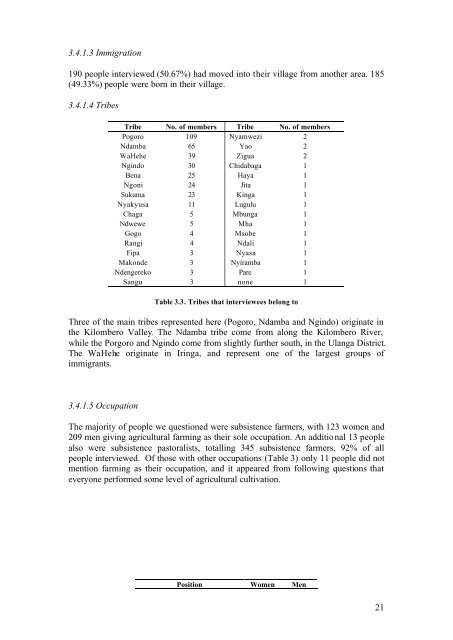Frontier Tanzania Environmental Research - Frontier-publications ...
Frontier Tanzania Environmental Research - Frontier-publications ...
Frontier Tanzania Environmental Research - Frontier-publications ...
You also want an ePaper? Increase the reach of your titles
YUMPU automatically turns print PDFs into web optimized ePapers that Google loves.
3.4.1.3 Immigration190 people interviewed (50.67%) had moved into their village from another area. 185(49.33%) people were born in their village.3.4.1.4 TribesTribe No. of members Tribe No. of membersPogoro 109 Nyamwezi 2Ndamba 65 Yao 2WaHehe 39 Zigua 2Ngindo 30 Chidabaga 1Bena 25 Haya 1Ngoni 24 Jita 1Sukuma 23 Kinga 1Nyakyusa 11 Lugulu 1Chaga 5 Mbunga 1Ndwewe 5 Mha 1Gogo 4 Msobe 1Rangi 4 Ndali 1Fipa 3 Nyasa 1Makonde 3 Nyiramba 1Ndengereko 3 Pare 1Sangu 3 none 1Table 3.3. Tribes that interviewees belong toThree of the main tribes represented here (Pogoro, Ndamba and Ngindo) originate inthe Kilombero Valley. The Ndamba tribe come from along the Kilombero River,while the Porgoro and Ngindo come from slightly further south, in the Ulanga District.The WaHehe originate in Iringa, and represent one of the largest groups ofimmigrants.3.4.1.5 OccupationThe majority of people we questioned were subsistence farmers, with 123 women and209 men giving agricultural farming as their sole occupation. An additional 13 peoplealso were subsistence pastoralists, totalling 345 subsistence farmers, 92% of allpeople interviewed. Of those with other occupations (Table 3) only 11 people did notmention farming as their occupation, and it appeared from following questions thateveryone performed some level of agricultural cultivation.Position Women Men21
















